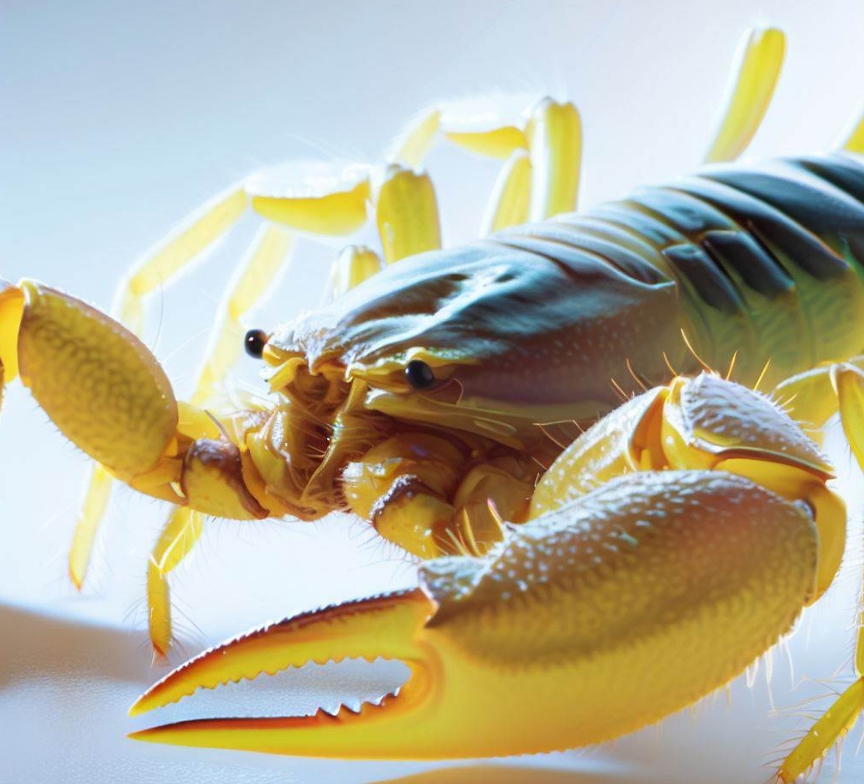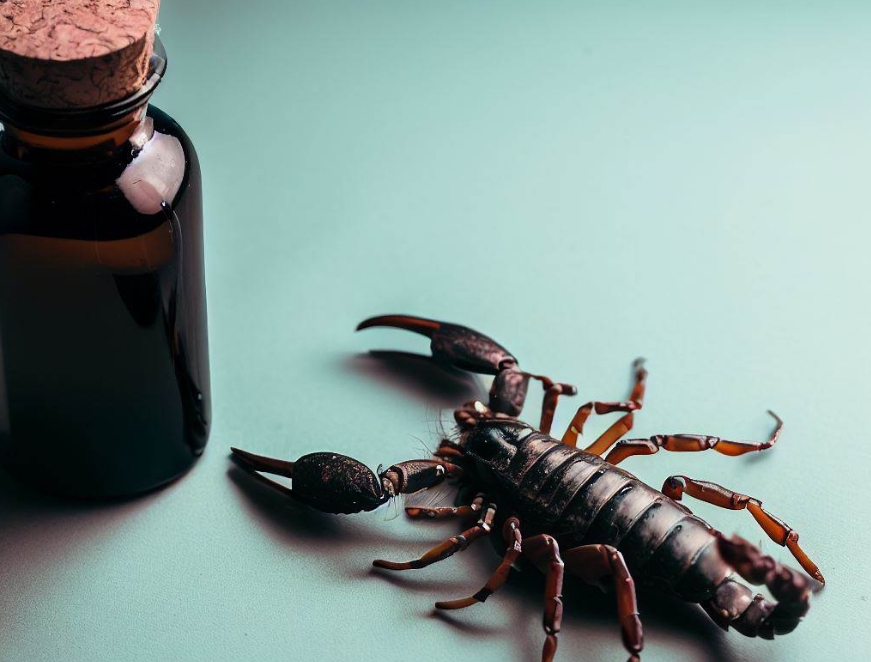Are you curious about the elusive and mysterious clear scorpion? Look no further! In this comprehensive guide, we’ll dive into the captivating world of these fascinating creatures, exploring their biology, adaptations, and more. As we unravel their secrets, we’ll also uncover the connections between scorpions and some unexpected relatives. So, let’s embark on this thrilling journey together!
What is a Clear Scorpion?
Contents
A clear scorpion is a unique type of scorpion with transparent or semi-transparent exoskeletons. This feature makes them particularly intriguing to researchers and enthusiasts alike. But before we delve deeper into the world of clear scorpions, let’s take a step back and understand the broader context.
Scorpions: A Brief Overview
Scorpions are arachnids, not insects, belonging to the class Arachnida, alongside spiders, ticks, and mites. They are predatory arthropods with eight legs, two large pincers, and a long, segmented tail tipped with a venomous stinger.
Scorpions are found in various habitats worldwide, including deserts, grasslands, forests, and caves. They’re also known for their ultraviolet and black scorpions, which glow under UV light, making them easier to spot during night-time research expeditions.
Scorpions and their Unexpected Relatives
You might be surprised to learn that scorpions are related to lobsters. Both creatures belong to the phylum Arthropoda, which means they share some common ancestry. However, their evolutionary paths diverged long ago, leading to the distinct forms and lifestyles we observe today.
Clear Scorpions: A Closer Look
Now that we’ve set the stage, let’s dive deeper into the captivating world of clear scorpions.
Anatomy and Transparency
Clear scorpions have a unique appearance due to their translucent exoskeleton. This transparency enables them to blend in with their surroundings, making them masters of camouflage. However, their organs and internal structures are still visible, providing a rare glimpse into the inner workings of these amazing creatures.
Species and Distribution
There isn’t a single species of scorpion known as the “clear scorpion.” Instead, the term encompasses various species with transparent or semi-transparent exoskeletons. These species can be found in different regions worldwide, with some clear scorpion species native to North America and others inhabiting the tropical rainforests of Southeast Asia.
Scorpion Adaptations: The Key to Survival
Scorpions have evolved a range of remarkable adaptations that allow them to thrive in their respective environments. Let’s explore some of these adaptations and how they contribute to the clear scorpion’s unique abilities.
Camouflage
The clear scorpion’s transparency is its most notable adaptation. This camouflage tactic allows them to blend seamlessly into their surroundings, hiding from predators and sneaking up on prey. In combination with their nocturnal lifestyle, clear scorpions become virtually invisible to both prey and predators.
Sensory Adaptations
Scorpions rely on their highly developed sensory organs to navigate their environment, locate prey, and avoid predators. These organs include:
- Pectines: Comb-like structures on their abdomen that detect vibrations, helping scorpions locate prey and potential mates.
- Chemoreceptors: These specialized sensory organs allow scorpions to detect chemical cues in their environment, such as pheromones or the scent of potential prey.
- Tactile Hairs: Scorpions are covered in sensitive hairs that can detect changes in air currents, temperature, and humidity. These hairs help them sense their surroundings and avoid potential threats.
Venom and Stinger
Scorpions are known for their venomous stingers, and clear scorpions are no exception. Their stingers contain a potent venom that can immobilize or kill their prey. This venom also serves as a powerful deterrent against predators. The potency of the venom varies among different scorpion species, but it is generally most dangerous to smaller animals and rarely life-threatening to humans.
Regeneration
Another fascinating adaptation of scorpions, including clear scorpions, is their ability to regenerate lost limbs or other body parts. This regenerative ability allows them to recover from injuries and continue hunting, mating, and surviving in their environment.
Clear Scorpions: Friends or Foes?
With their venomous stingers and stealthy camouflage, clear scorpions may seem like creatures to avoid. However, it’s essential to recognize the valuable role they play in their ecosystems.
Predators and Prey
As predators, clear scorpions help control insect and arachnid populations, maintaining a balanced ecosystem. They primarily feed on insects, spiders, and other small arthropods, but larger scorpion species may even consume small vertebrates such as lizards or rodents.
In turn, scorpions are prey for various animals, including birds, mammals, and reptiles. This predator-prey relationship highlights the interconnectedness of ecosystems and the critical role that clear scorpions play in maintaining balance.
Pest Control
Clear scorpions can also be beneficial to humans by controlling pests in our homes and gardens. For example, they may help to reduce populations of insects that damage crops or transmit diseases. So, while their venomous stingers may seem intimidating, clear scorpions can be helpful allies in our ongoing battle against pests.
A World Beyond the Clear Scorpion
While the clear scorpion is undoubtedly fascinating, it’s just one small piece of the vast scorpion world. Other notable species include the yellow-tailed scorpion, which is native to North Africa and Southern Europe but has established populations in the United Kingdom. This species is also known for its unique ability to survive in urban environments, making it an exciting subject of study for researchers.
Conclusion
The clear scorpion’s unique appearance and fascinating adaptations make it a captivating subject for enthusiasts and researchers alike. By understanding their biology, behavior, and the critical role they play in their ecosystems, we can better appreciate these remarkable creatures and the diverse world of scorpions.
FAQ about Clear Scorpions
To help you further understand the world of clear scorpions, we’ve compiled a list of frequently asked questions and their answers.
Q: Are clear scorpions dangerous to humans?
A: While clear scorpions have venomous stingers, their venom is generally not life-threatening to humans. However, some individuals may have allergic reactions to scorpion venom, which could be dangerous. It’s essential to exercise caution and avoid handling scorpions in the wild.
Q: Can clear scorpions be kept as pets?
A: Scorpion keeping is a niche hobby, and some enthusiasts may keep clear scorpions as pets. However, it’s crucial to research the specific species and their care requirements before obtaining a clear scorpion as a pet. Additionally, make sure to adhere to local laws and regulations regarding exotic pet ownership.
Q: How can I identify a clear scorpion in the wild?
A: Clear scorpions can be identified by their translucent or semi-transparent exoskeletons. They may be harder to spot than other scorpion species due to their camouflage, but their distinct appearance makes them recognizable once found. Remember, scorpions are nocturnal creatures, so you’re more likely to encounter them at night.
Q: What is the lifespan of a clear scorpion?
A: The lifespan of a clear scorpion varies depending on the species, but most scorpions live for 2-10 years. Some species may even live up to 25 years under optimal conditions.
Q: How do clear scorpions reproduce?
A: Scorpions reproduce sexually, with males depositing a spermatophore on the ground, which the female then picks up with her genital opening. After fertilization, the female gives birth to live young (viviparous), carrying them on her back until they molt for the first time and disperse.
Q: How do I get rid of clear scorpions in my home?
A: If you have a clear scorpion infestation in your home, it’s essential to address the issue promptly. You can take several preventative measures, such as sealing gaps and cracks, removing debris and clutter, and controlling insect populations that serve as their food source. For more severe infestations, it’s recommended to consult with a professional pest control service.
Q: Do clear scorpions have any predators?
A: Yes, clear scorpions have predators, including birds, mammals, and reptiles. These predators help maintain balance in ecosystems by keeping scorpion populations in check.





